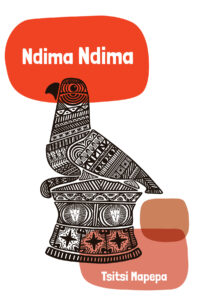
Ndima Ndima is Zimbabwean writer Tsitsi Mapepa’s debut novel, published by Catalyst Press in 2023. The narrative unfolds through at least three interconnected sub-narratives. The first sub-narrative delves into the experiences of Zuva and her family in Harare, exploring the intricate (dis)harmony between nature and humanity. A second narrative thread traces Zuva’s past, encompassing her relationship with her late parents, her involvement in the liberation war, the power struggle with her siblings, and her subsequent reclaiming of authority in the present. The ultimate subplot chronicles the growth of Zuva’s four daughters, with a particular focus on Nyenyedzi, whom Zuva designates as the heir to her Chieftainship.
Throughout the story, Zuva emerges as a formidable woman in her neighbourhood and a respected Chief in her place of birth. Possessing the ability to communicate with spiritual entities, she stands as the sole individual that Selina, a water-dwelling creature, a mermaid, created in the image of the Nigerian Mama water, heeds.
The term ‘Ndima’ in Shona, the language predominantly spoken in Zimbabwe, traditionally refers to a piece of land utilized for agricultural purposes. However, in Tsitsi Mapepa’s novel, this word takes on a new dimension, symbolizing an imagined traditional dance enacted during a rainmaking ritual. This dance serves as a remedy for the severe drought that evokes the historical drought of 1992. The rainmaking ritual, deeply rooted in indigenous practices, becomes a means of addressing the challenges posed by a ravaging climate crisis. The narrative explores indigenous beliefs, connecting the drought to the tragic events of the war, with speculation that the high death toll during the war conflict is a contributing factor to the current crisis.
Despite the title’s association with the ritual dance, the novel’s central theme revolves around land. It is worth noting that, it does not emphasize the political aspects of land, as often portrayed in stories following the contested land reappropriation of the 2000s, a significant factor in the Zimbabwean crisis. Instead, the focus shifts to the protagonist, Zuva, and her profound connection with the land upon which her family erected their second home. The land, distinguished by its fertile red soil and environment teeming with snakes, holds significant importance within the narrative. Mapepa skillfully explores the intricate relationship between humans and nature, highlighting both its nurturing aspects and the inherent threats to survival for both parties through the portrayal of the land.
In that way, the novel intricately weaves ecological themes into its fabric. The uneasy coexistence between humans and the natural habitat, particularly snakes, unfolds as a recurring conflict. The snakes pose a threat to Zuva’s family and neighbors, prompting a violent response of killing them to ensure human safety. In a parallel struggle, humans contend with pests such as lice and rats, leading to retaliatory violence. For example, the rats are flushed down the toilet, depicting a dynamic of predator and prey. Amidst these conflicts, instances of harmonious coexistence with other aspects of nature also emerge.
The harmonious interaction between nature and humans, for instance, involves humans benefiting from the moon’s light at night, trees providing shade on hot days, and the earth’s soil supplying iron to pregnant women. Mwedzi, Zuva’s husband recounts folktales that illustrate animals talking and interacting with humans. This aligns with Ngugi wa Thiongo’s (1998) perspective that:
Humans are undeniably part of nature. In that sense, they are no different from animals and plants, all reliant on the same environment of earth, air, water, and sun… orature takes that as a given. Thus, in orature narratives, humans, birds, and plants interact freely, often assuming each other’s forms, including language.
This ecological focus of the narrative explores human agency in the climate crisis, exemplified by Zuva’s actions to combat troublesome snakes in her neighborhood. She burns the grass to start a fire, boiling water that she uses to ‘burn’ the snakes to death. The smoke from the fire dissipates into the air, forming a thick grey blanket (3).
The interaction between humans and nature is further realised in the novel’s structure and characterization that expose an ecological preoccupation. One significant narrative strategy involves including a mermaid (half female and half fish), an aquatic feature through which Mapepa explores the concern with possibilities of harmonious interaction between humans and nature. Human character names that evoke celestial bodies like Zuva (sun), Nyeredzi (star), Mwedzi (moon) and others that refer to diverse climatic features Gwenga (desert), and Dutu (storm), as well as street names and toponyms like Chakohwa (harvest), are influenced by the environment. The first chapter, named ‘Sunset Street,’ is set during the autumn of 1990, with seasons defining settings throughout the narrative that concludes in the spring of 2003.
In Mapepa’s novel, natural threats complement human threats, such as murder along the river, past violence from the liberation war, evoked in the narrative through references to Abigail and Mwedzi’s ‘deep hollowed’ scars from the war. Traumas of the war, suicides, and the presence of thugs threatening everyone, with women facing specific challenges like attempted rape, further contribute to the intricate narrative of ‘crisis’ and human agency.
Mapepa’s novel addresses a seldom-explored theme in the Zimbabwean literary canon, diverging from the prevalent focus on the Zimbabwean crisis that often overlooks the climate change crisis.
Tsitsi Mapepa, Ndima Ndima (El Paso: Catalyst Press 2023)
References
Ngugi, wa Thiong’o. 1998. Penpoints, Gunpoints, and Dreams: Towards a Critical Theory of the Arts and the State in Africa. Oxford: Clarendon Press.
Tendai Mangena, British Academy Global Professor of African Studies, School of Philosophy, Religion and History of Science, University of Leeds (T.Mangena@leeds.ac.uk)
